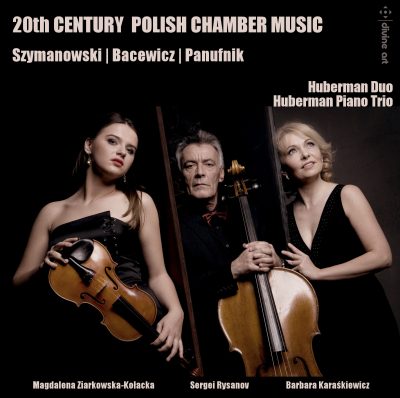Grażyna Bacewicz Recordings
Bacewicz is absolutely unique and for several reasons. It will not be an exaggeration to say that she summed up the two hundred year span from Mozart through Chopin, Liszt, Paganini, Wieniawski, to Rachmaninoff – of great virtuoso-composers who combined mastery in playing an instrument with creating music at the highest level. She is also the first female composer of this rank and not only in Polish culture.
In 1934, when Panufnik wrote his Piano Trio, in Warsaw (on May 10) the “Grażyna Bacewicz’s Composing Evening” took place, during which in the first part she personally (and notably!) performed her six pieces on the piano, and in the second part, three on the violin. She was indeed an extremely talented and educated artist. As a composer, she made her debut in her hometown of Łódź at the age of 15 with her Theme and Variations for piano. Also in this city, even earlier – as a seven-year-old – she had begun public performances.
In 1927 at the Łódź Philharmonic she played Mendelssohn’s Piano Concerto in G minor, and in 1935 she won the first distinction at the first H. Wieniawski International Violin Competition in Warsaw. She gave up virtuoso piano playing as a twenty-year-old, playing the violin until 1953 (often together with her brother Kiejstut, a pianist). Immediately after World War II, she led the violin class at the State Conservatory of Music in Łódź, and until the end of her life she taught composition at the Warsaw State College of Music. Add to this her philosophical studies and literary activity – her crime novel Sidła, a volume of short stories Znak szczególny – and she can be identified as a unique and remarkable figure.
Grażyna Bacewicz came from a Polish-Lithuanian family, broken by political turmoil after World War I. Her father Vincas Bacevičius and her second brother Vytautas (also a composer) moved to a reborn Lithuania in 1923; the other family members – her mother Maria Modlińska, brother Kiejstut and sisters Wanda and Grażyna – chose Poland as their homeland. After moving to Warsaw, Bacewicz began her studies at the Conservatory in the composition class of Kazimierz Sikorski. Then she went to Paris, often referred to at the time the “Mecca of new music”, to improve her skills under the guidance of Nadia Boulanger. There she learned and accepted the principles of neoclassicism, and from the Boulanger class she took, like many others “the cult of composer’s craft, the cult of classical formal patterns, a tendency to emphasize purely musical values, not burdened with literary and ideological baggage.” (Zofia Helman).
Until the outbreak of World War II, Bacewicz’s portfolio included, among others, Sinfonietta for small string orchestra, Violin Concerto No. 1, String Quartet No. 1 and several other chamber works, from duo to quintet. During the years of occupation, her achievements were enriched by further works, including Symphony No. 1, Overture for symphony orchestra, String Quartet No. 2 and several piano and violin pieces.
As for many Poles, so was it for the 36-year old artist that the end of the war did not herald the beginning of a more joyful time. Fascist terror was replaced by communist terror, which was also reflected in the field of culture. According to the doctrine of socialist realism, creators were obliged to contribute to the development of the new system. In music it came down to observing four main orders: “Eliminating subjectivity, cultivating the national character of music, using only commonly accepted forms, the participation of composers and musicologists in the process of music education” (Charles Bodman Rae). Admittedly Grażyna Bacewicz had no major problem finding herself in the new reality, unlike Panufnik, who, unable to bear the ideological straightjacket imposed by the authorities, successfully escaped to Great Britain in 1954. Although she did not write a cantata in honor of Stalin, the Soviet Union or Polish People’s Republic, but in this “absurd, simply Orwellian tragicomedy of totalitarianism” she lived, created and collected awards. Her post-war work is impressive: three more symphonies, six violin concertos, cello concerto, viola concerto, piano concerto, a number of violin and piano works, as well as numerous chamber works, among which, apart from six string quartets and five sonatas for violin and piano.











![Listen to the full suite of Marcel Dupré’s Variations Sur un Noël, Op. 20 from Alexander Ffinch’s #Expectations release today! listn.fm/expectations [in bio]](https://scontent-dfw5-1.cdninstagram.com/v/t51.71878-15/588904367_2327488161082898_8709236950834211856_n.jpg?stp=dst-jpg_e35_tt6&_nc_cat=105&ccb=7-5&_nc_sid=18de74&efg=eyJlZmdfdGFnIjoiQ0xJUFMuYmVzdF9pbWFnZV91cmxnZW4uQzMifQ%3D%3D&_nc_ohc=H8WFKm530VcQ7kNvwEyxu1V&_nc_oc=AdlbP-daCzbV5Xhy24rxONs3Y1t1ko-OxMhg9wYSjvUnSn34yMKfTBi0oY93R6UsYs0lXVqSY2Ce8tF2X6mMo1Gu&_nc_zt=23&_nc_ht=scontent-dfw5-1.cdninstagram.com&edm=ANo9K5cEAAAA&_nc_gid=HMFfYBGspjj6-ZY9paU00w&oh=00_AflWpdJZsDQZZUtz4JvIusFxURer_W5MmfESCeQcTHZvRg&oe=6954C06A)

![“the ‘Manteca’ Paraphrase – a rare foray into the two-piano medium but here played double-tracked – exudes a panache of which Dizzy Gillespie would surely have approved.… [a] recital well worth investigating.” —Gramophone Magazine with high praise for Ophelia Gordon's debut release, Kapustin: Between the Lines!](https://scontent-dfw5-3.cdninstagram.com/v/t51.82787-15/598796470_18303255136283342_540941604740887837_n.jpg?stp=dst-jpg_e35_tt6&_nc_cat=108&ccb=7-5&_nc_sid=18de74&efg=eyJlZmdfdGFnIjoiRkVFRC5iZXN0X2ltYWdlX3VybGdlbi5DMyJ9&_nc_ohc=IC4zZ7tcpb8Q7kNvwG0AnwY&_nc_oc=Adk-fe0Nme2NQebSWNQYltibA7dHSTiGO9MLWqH2Voah5EWEx839VrXkwi0WyMrWLrXjyyERgCnuiTFzA5XHTU78&_nc_zt=23&_nc_ht=scontent-dfw5-3.cdninstagram.com&edm=ANo9K5cEAAAA&_nc_gid=HMFfYBGspjj6-ZY9paU00w&oh=00_Afk7Buj8dy9-zp975XvNo-jPrdJRKZwh391d7qLjDHvV6Q&oe=6954D304)